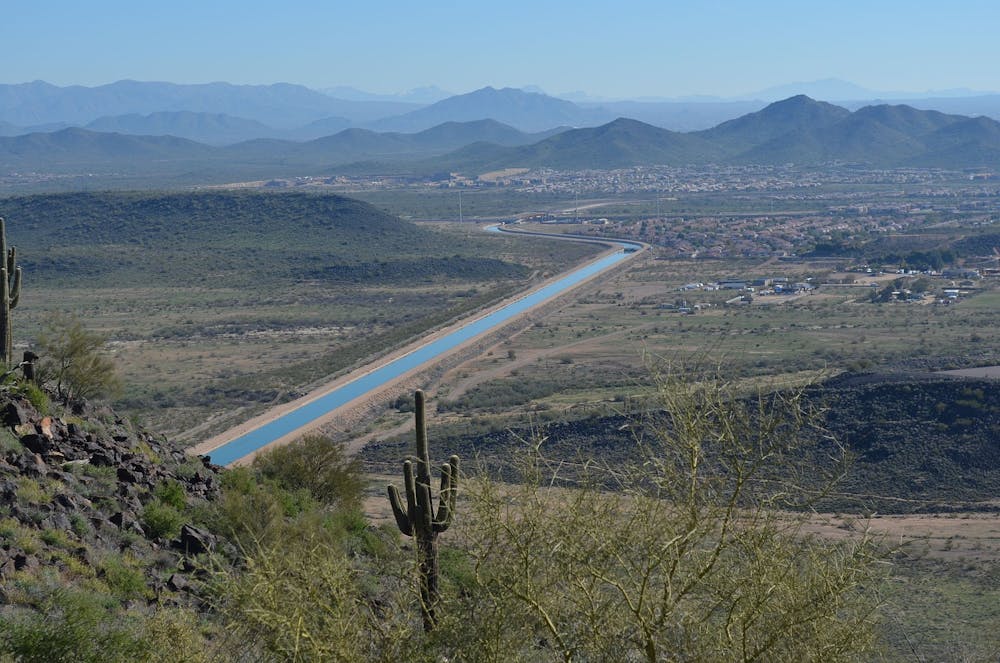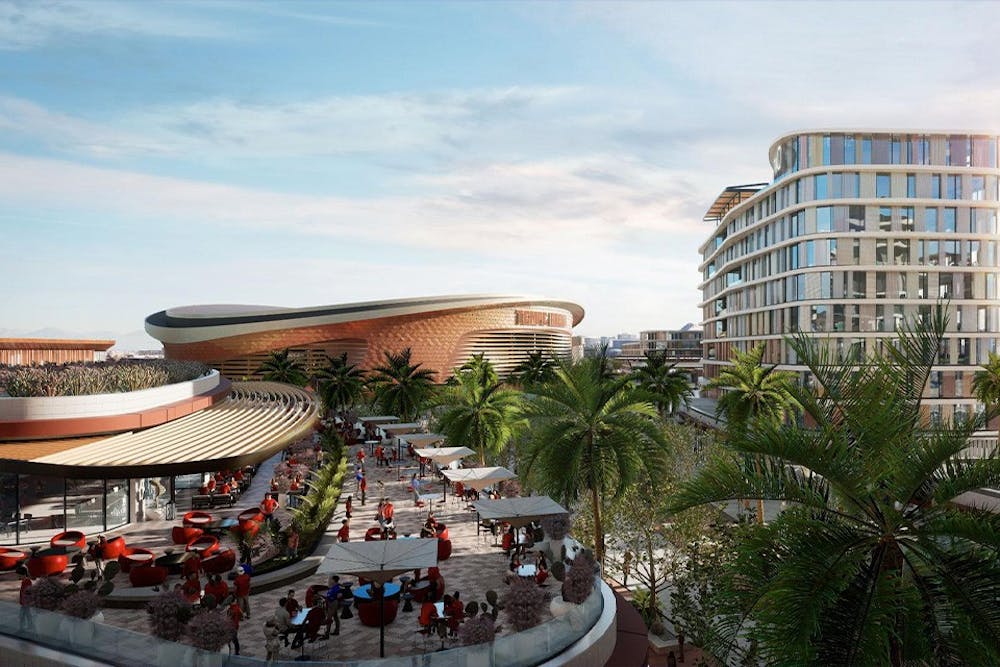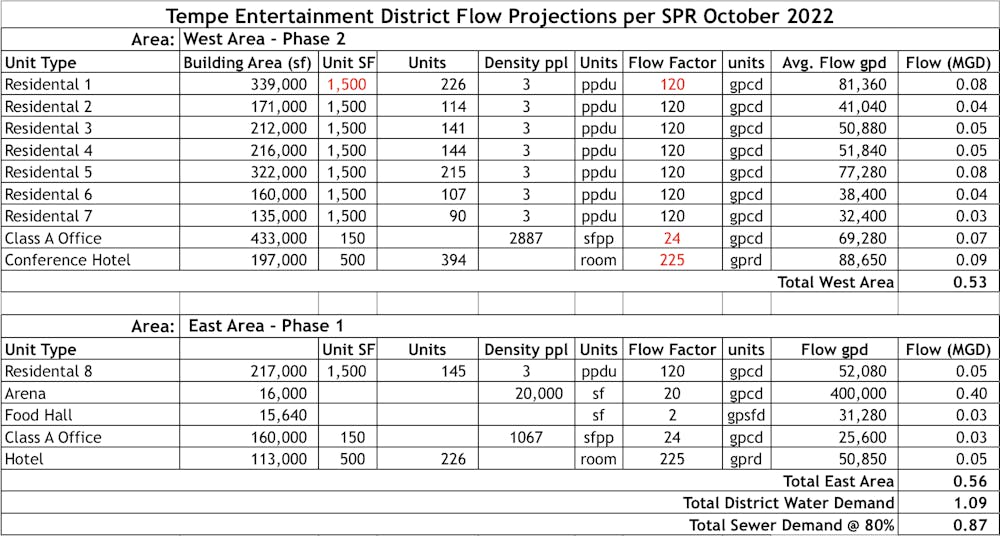A water flow analysis acquired from the city of Tempe says tenants could use upward of 1.09 million gallons of water per day in the proposed Arizona Coyotes and Tempe entertainment district.
While water officials said this number isn't massive compared to typical city water usage, the entertainment district wouldn't use water from the city's largest and most sustainable source. Instead, it would come from remaining sources of Tempe's water supply that are less sustainable or reliable, like the Central Arizona Project, the 336-mile diversion canal that provides water from the Colorado River to areas of central and southern Arizona.
According to the city of Tempe's water resources master plan published in August 2021, about 82% of the city's water came from Salt River Project surface water member supplies. This water is only accessible on land that falls within the boundaries of SRP's private water association, the Salt River Valley Water Users Association. These lands are often referred to as SRP member lands.
The land the Coyotes are hoping to build on, like most developments along the bank of the Salt River, is not located on SRP member lands, therefore it cannot receive water from SRP’s surface water supply. Randy Miller, a member of SRP's Association Board, confirmed SRP would not provide water directly to the district. The water for the district will come from a combination of CAP water, groundwater and from the limited supply from Roosevelt Lake.
READ MORE: Tempe special election for Arizona Coyotes arena and entertainment district, explained
Tempe's communications and media relations manager Nikki Ripley said in an email "the preliminary flow projections determined (the Tempe entertainment district) will have limited potential impact on existing infrastructure and aligns with our existing General Plan for the area."
Breakdown of water usage in the entertainment district
The October 2022 analysis acquired from the city shows average flow in gallons per day for seven types of residential units, office spaces, a conference hotel, arena, food hall and more attractions that would be part of the district. One million gallons of water is enough to support about nine Arizona single-family homes for one year.
According to the analysis, the arena is projected to use up to 400,000 gallons of water on days the arena hosts live events, like a Coyotes home game. In the 2018-19 season, the team’s final season before the COVID-19 pandemic, the Coyotes played 41 regular season games at Glendale’s Gila River Arena, now called Desert Diamond Arena.
The farthest right column of the chart is approximate water flow measured by millions of gallons per day (MGD). It reflects the number in the column to its left, the average flow “gpd,” or gallons per day.
Victor Aronow, an attorney who has lived in Tempe for nearly 50 years, said the study likely underestimates the project’s total water use given the document does not include the second planned ice rink designed for Coyotes practice and community use or the project’s live music venue.
Tempe's water portfolio in comparison to entertainment district water usage
The district, which would sit on the northeast corner of Priest Drive and Rio Salado Parkway, would not have access to the majority of the city's water supply. According to the city of Tempe's 2021 consumer confidence report, the city averaged 42.3 million gallons of potable water distributed to citizens per day.
The city of Tempe is in charge of providing water to the project using the remaining 18% of the city’s water portfolio which, according to the master plan, comes from three sources. One is CAP, which the master plan says is primarily used to meet water demands on lands not entitled to SRP water supplies, like lands the Coyotes hope to build on.
Seven states across the Southwest, including Arizona, rely heavily on reservoirs fed by the Colorado River to supply water to the region’s rapidly growing populations. The New York Times reported earlier this month that President Joe Biden's administration has proposed cuts to Arizona’s Colorado River water supply of up to one-quarter of current levels during current long-term drought conditions.
The difference is made up by groundwater, which is subject to state regulation under the Groundwater Management Act of 1980, and New Conservation Space water from SRP. This water is not restricted to SRP member lands and comes from the Modified Roosevelt Dam, and it is variable from year to year.
According to a May 2021 report from ASU's Kyl Center for Water Policy, current laws have allowed Arizona’s groundwater supply to become overallocated, causing an unsustainable level of pumping that could jeopardize the state’s groundwater aquifers.
“Each development plan is reviewed independently for the impact on the existing water infrastructure and water resources portfolio. These impacts are then considered across all existing and proposed water uses for Tempe through the General Plan,” Ripley said in an email. “Tempe is fortunate to have a diverse and robust water resources portfolio.”
Sustainability and the entertainment district's water plan
Rhett Larson, a professor of water law at ASU's Sandra Day O’Connor College of Law, said in an email that because the project would fall outside of SRP member lands, “it’s not in as good a water position as it could be if it were within that area.”
He said the district was still a very minor water consumer in a reasonably water-secure area.
Arizona Coyotes President and CEO Xavier Gutierriez said the water flow projection assumed “peak usage” across the district, meaning it reflected days when the district would experience its maximum water demand. He also said the 7-0 vote of approval for the referendum from Tempe City Council came after analysis from city staff indicating the Coyotes have an assured water supply for the project, as is state law for all developments over five units.
Tempe Mayor Corey Woods said the project’s nearly 2,000 apartments are less water intensive than other forms of housing and said he is confident in the city’s internal processes to ensure the development will not jeopardize the city’s long-term water prospects.
Woods said the city’s office of sustainability and resilience is tasked with conservation and energy efficiency standards. He also said the city sometimes employs third-party experts to ensure water security for new developments.
“I would say that this project, like the other projects that we’ve approved … is compatible not only with land use, but it’s also compatible with our energy, energy efficiency and water conservation goals,” Woods said.
The project’s supporters have praised its potential environmental benefits, which often center around the removal of a landfill. Tempe Wins, a political action committee in favor of the development, has called the landfill “hazardous” since the PAC's creation in December 2022.
At a March press conference, Tempe Wins chair Nick Bastian said he thought concerns over the project’s water use were “laughable.”
“That hockey arena does not use a lot of water,” Bastian said. “When you look at other commercial developments in the area, when you look at golf courses, you look at any kind of city facilities, it's not going to be a huge user of water.”
Gutierrez cited the research and development park being built in ASU’s Novus Innovation Corridor and other planned developments along Tempe Town Lake as other projects with water usage that ought to be scrutinized.
“One of the questions that we have asked to those that have critiqued our approach is: Are similar questions being asked for all the other development that is occurring along Tempe Town Lake?” Gutierrez said. “Because the last thing that we would want is to be solely pointed out as the only development going on that I think needs to address a lot of these water issues.”
Larson said total water use is not the only consideration when evaluating a project of this scope. Tempe Wins claims the project will create 6,900 new jobs.
“How many jobs are you creating per drop of water?” Larson said.
What happens next
The project's approval hinges on the passage of all three propositions in the May 16 special election, Props. 301, 302 and 303. The propositions would approve the rezoning and amending of the city's general plan, as well as the sale of the 46-acre plot of land to Bluebird Development LLC, Coyotes owner Alex Meruelo's development company.
Meruelo's Bluebird would be in charge of constructing a new 16,000-seat Arizona Coyotes arena, a nearly 350,000 square foot shopping and dining center and nearly 2,000 housing units. The project proposal also includes an in-person sports betting facility and a second ice rink that will serve as a practice facility and community ice skating rink.
The development comes at a crucial moment in history for the Colorado River. Not only do the river’s two primary reservoirs, Lake Mead and Lake Powell, provide water to southwestern states, their dams generate hydroelectricity that powers homes and businesses. The reservoirs’ levels have recently fallen so low they could reach deadpool, meaning soon the dams will no longer have the capacity to generate electricity.
The special election is the last hurdle in what has been a multi-year campaign by the Coyotes to find a new home after a tumultuous 19-year tenure in Glendale. The Coyotes recently finished their first season at ASU's Mullett Arena, their home for at least the next two seasons.
Woods said the decision to bring the vote to the public was purposeful, to give the voters a say in the development, especially when the City Council typically votes on everything else.
"We knew that whenever you're talking about professional sports teams and arenas, given what has happened across the country, these are always controversial situations," Woods said. "...We thought in this situation it would be best not for the council to make the final decision, but instead for our residents to make the final decision."
Ballots are due May 16. If approved by voters, phase one of the project, which includes the arena, is set to be completed some time in 2025.
Edited by Shane Brennan, Piper Hansen and Greta Forslund.
Reach the reporter at awakefi3@asu.edu and follow @_alexwakefield on Twitter.
Like The State Press on Facebook and follow @statepress on Twitter.






